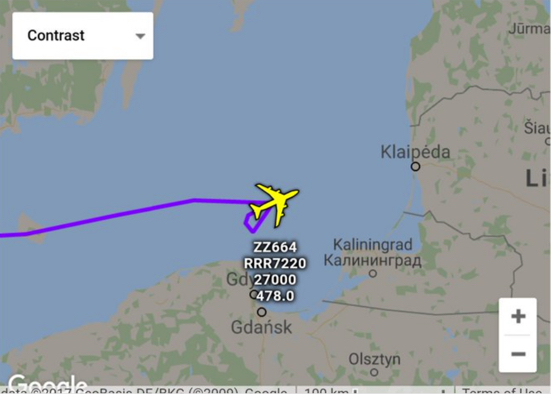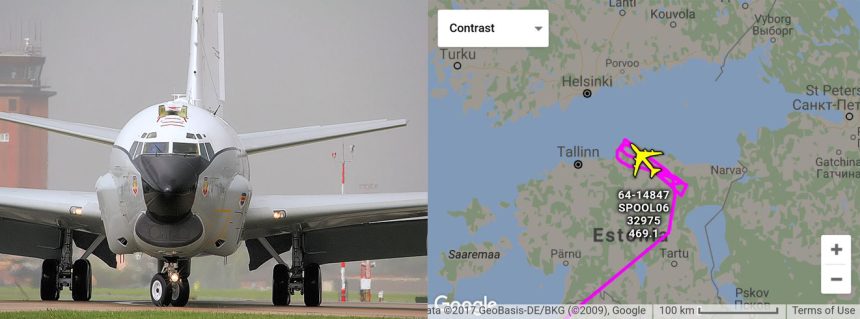Yesterday two USAF F-35A stealth aircraft performed a quick visit to Estonia. But their mission to the Baltic region was probably not only supported by a KC-135: an RC-135U and two RC-135Ws flew to the area while the 5th Gen. jets were there.
On Apr. 25, two U.S. Air Force F-35As belonging to the 34th Fighter Squadron, from Hill Air Force Base, Utah, deployed to the UK since mid April, flew from RAF Lakenheath, UK, to Ämari, Estonia.
Based on the information gathered by aircraft spotters, airband listeners and ADS-B monitors, who tracked the mission to Estonia of the F-35s, the two 5th generation multirole combat aircraft , 14-5102 and 14-5094, using radio callsign “Conan 01” and accompanied by “Quid 89”, a 100ARW KC-135 from RAF Mildenhall, departed from RAF Lakenheath at 07.35z.
The trio landed in Estonia shortly before 11.00z and took part in a brief ceremony (at this link you can find some interesting photographs).
Noteworthy, the quick visit to Estonia was “accompanied” by a rather unusual activity of U.S. and British spyplanes in the Baltic region.
In fact, as the F-35s headed towards Amari in formation with their KC-135 tanker, as many as three RC-135s (including a RAF bird) operated in the airspaces over or close to Estonia.
The U.S. Air Force dispatched an RC-135W Rivet Joint 62-4139 “Haiti 79” and an RC-135U Combat Sent 64-14847 “Spool 06” to the Baltic states.
The Rivet Joint positioned off Kaliningrad Oblast, where some of the most active Russian bases in the Baltic region are located, whereas the Combat Sent started a racetrack over Estonia, not far from the border with mainland Russia.
Race tracks @ 33,000ft over #Estionia
?? US Air Force – Combat Sent
RC135U 64-14847 SPOOL06 pic.twitter.com/xAoBTPhwKE
— CivMilAir ✈ ? (@CivMilAir) April 25, 2017
Shortly thereafter, even a RAF RC-135W “Airseeker,” one of the three ex-USAF KC-135 tanker converted to the Rivet Joint variant starting back in 2011, from RAF Waddington joined the scene. The British intelligence gathering plane that, just like the American “RJs” is equipped with all sorts of antennae and sensors, to eavesdrop enemy signals, transmissions, detect frequencies used by radio and radars and pinpoint sites of interest, mobile stations, SAM batteries, etc., maintained a racetrack off Kaliningrad.

At 14.43Z, the two JSFs departed Ämari to return to the UK and shortly thereafter both the U.S. and RAF spyplanes headed back to their homebases.
Although we can’t but speculate here, it appears to be quite likely that the RC-135 missions to the Baltic were somehow related to the deployment of the F-35 so close to the Russian border. In fact, whilst Rivet Joint and Combat Sent aircraft regularly fly to the region and can be daily tracked online as they head towards the international airspace off Lithuania, Estonia and Latvia, the presence of three such spyplanes not too far away from one another seems to suggest their missions were coordinated and probably related to something “big” happening there.
And the only “big thing” (Zapad 2017 preparation aside) we are currently aware of is the first presence of the JSF in Estonia. Moreover, not only was the type of racetrack flown by the Combat Sent unusual, but it was also located in a pretty interesting position: east of Ämari, as if the RC-135U, an aircraft designed to collect technical intelligence on adversary radar emitter systems, was there to detect emissions from Russian radars interested in the F-35.
Smooth move – US Air Force had a RC-135U Combat Sent spotting RU radar signals while those F-35As visited Ämari AB.
Track via @CivMilAir pic.twitter.com/ArAcADxlv0
— Arto Pulkki (@APulkki) April 25, 2017
However, there is another possibility: what if the American and British spyplanes were there to deter the Russian from using their radars?
Indeed, whilst three RC-135s flying at the same time in the same area is something unusual, it is quite weird that the three spyplanes had their ADS-B transponder turned on during their missions.
“If they wanted to hide, they would do” says the ADS-B / ModeS tracking enthusiast who runs the popular @CivMilAir and @ADSBTweetBot Twitter feeds. “The daily RC-135s flights over the Middle East very rarely show up and even the daily missions to the Baltics can usually be tracked during their transit to the area of operations, where often the transponder is turned off. That’s why I believe they remained trackable on purpose.”
Spyplanes, including the U-Boat (as the RC-135U Combat Sent is nicknamed in the pilot community), usually operate in “due regard” with transponder switched off, with no radio comms with the ATC control, using the concept of “see and avoid” where the pilot flying is responsible for avoiding all traffic conflicts. Even if RC-135s can be regularly tracked online, they tend to keep a low-profile when reaching the area of operations, turning off the ADS-B to avoid being detected at least by commercial ADS-B receivers like those feeding online flight tracking systems such as Flightradar24.com, PlaneFinder.net or Global ADS Exchange.
On Apr. 25, both RC-135s could tracked throughout their missions suggesting they did purposely broadcast their position for everyone to see, to let everyone know they were there.
Russian spyplanes have done pretty much the same in the past: the Tu-214R, Russia’s most advanced intelligence gathering aircraft deployed to Syria and flew along the border with Ukraine with its transponder turned on. In that case it was a sort of “show of force”; yesterday was likely a way to prevent some interesting details about the F-35 to be gathered by the Russians.
By the way, it’s not the first time U.S. stealth jets flying to the Baltics are directly or undirectly “accompanied” by Rivet Joints: on Apr. 27, 2016, two F-22s deployed to Siauliai Air Base, Lithuania. Supported (so to say) by an RC-135W.
H/T to @CivMilAir, @MIL_Radar, Fighter Control forum
Top image credit: Tim Felce (Airwolfhound) via Wiki Commons









